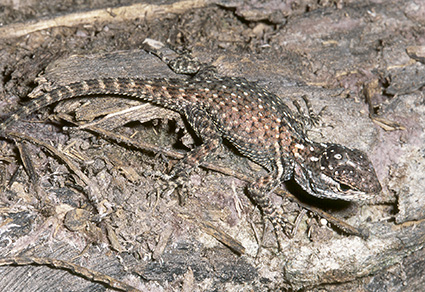Abstract
We describe Sceloporus huichol sp. nov., a new species of spiny lizard of the genus Sceloporus, that is found in the mountainous regions of Jalisco and Nayarit in western Mexico. The new species belongs to the torquatus species group and has previously been confused with Sceloporus melanogaster, from which it differs by its smaller size, head color and nuchal collar. Additionally, Sceloporus huichol sp. nov. is different from the rest of its congeners by relevant genetic and morphologicall data. Despite having a complete nuchal collar, characteristic of Sceloporus torquatus, S. huichol sp. nov. is more closely related phylogenetically to S. melanogaster. Recognition of this new species brings the number of species in the torquatus group to nine.
References
Bell, E.L., Smith, H.M. & Chiszar, D. (2003) An annotated list of the species-group names applied to the lizard genus Sceloporus. Acta Zoologica Mexicana, Nueva Serie, 90, 103–174.
Bryson Jr., R.W., Grummer, J.M., Connors, E.M., Tirpak, J. McCormack, J.E. & Klicka, J. (2021) Cryptic diversity across the Trans-Mexican Volcanic Belt of Mexico in the montane bunchgrass lizard Sceloporus subniger (Squamata: Phrynosomatidae). Zootaxa, 4963, 335–353. https://doi.org/10.11646/zootaxa.4963.2.5
Campillo-García, G., Flores-Villela, O., Butler, B.O., Velasco-Vinasco, J.A. & Ramírez-Corona, F. (2021) Hidden diversity within a polytypic species: The enigmatic Sceloporus torquatus Wiegmann, 1828 (Reptilia, Squamata, Phrynosomatidae). Vertebrate Zoology, 70, 781–798. https://doi.org/10.3897/vz.71.e71995
Canseco-Márquez, L., Smith, E.N., Ponce-Campos, P., Flores-Villela, O. & Campbell, J.A. (2007) A new species of Tantilla (Serpentes: Colubridae) of the calamarina group from Volcán Ceboruco, Narayit, Mexico. Journal of Herpetology, 41 (2), 220–224. https://doi.org/10.1670/0022-1511(2007)41[220:ANSOTS]2.0.CO;2
Díaz-Cárdenas, B. Ruiz-Sanchez, E. Castro-Felix, P. Castañeda-Gaytán, G. Ruiz-Santana, S. & Gadsden, H. (2017) Species delimitation of the blue-spotted spiny lizards within a multilocus, multispecies coalescent framework, results in the recognition of a new Sceloporus species. Molecular Phylogenetics and Evolution, 111, 185–195. https://doi.org/10.1016/j.ympev.2017.04.004
Lambert, S.M., Streicher, J.W., Fischer-Reid, M.C., Méndez de la Cruz, F.R., Martínez-Méndez, N., García-Vázquez, U.O., Nieto Montes de Oca, A. & Wiens, J.J. (2019) Inferring introgression using RADseq and DFOIL: Power and pitfalls revealed in a case study of spiny lizards (Sceloporus). Molecular Ecology Resources, 2019, 818–837. https://doi.org/10.1111/1755-0998.12972
Leaché, A.D. (2010) Species trees for spiny lizards (Genus Sceloporus): Identifying points of concordance and conflict between nuclear and mitochondrial data. Molecular Phylogenetics and Evolution, 54, 162–171. https://doi.org/10.1016/j.ympev.2009.09.006
Leaché, A.D., Banbury, B.L., Linkem, C.W. & Nieto-Montes de Oca, A. (2016) Phylogenomics of a rapid radiation: is chromosomal evolution linked to increased diversification in North American spiny lizards (Genus Sceloporus)?. BMC Evolutionary Biology, 16. [published online]
Martínez-Méndez, N., Mejía, O., Ortega, J. & Méndez-De la Cruz, F.R. (2019) Climatic niche evolution in the viviparous Sceloporus torquatus group (Squamata: Phrynosomatidae). PeerJ, 6:e6192. https://doi.org/10.7717/peerj.6192
Martínez-Méndez, N., Mejía, O., Rocha-Gómez, A. & Méndez-De la Cruz, F.R. (2012) Morphological convergence and molecular divergence: the taxonomic status of Sceloporus serrifer (squamata, phrynosomatidae) subspecies. Zoologica Scripta, 41(2), 97–108. https://doi.org/10.1111/j.1463-6409.2011.00509.x
Martínez-Méndez, N. & Méndez-de la Cruz, F.R. (2007) Molecular phylogeny of the Sceloporus torquatus species-group (Squamata: Phrynosomatidae). Zootaxa, 1609, 53–68. https://doi.org/10.11646/zootaxa.1609.1.2
Olson, R.E. (1986) A new subspecies of Sceloporus torquatus from the Sierra Madre Oriental, Mexico. Bulletin of the Maryland Herpetological Society, 22 (4), 167–170.
Smith, H.M. (1936) The lizards of the torquatus group of the genus Sceloporus Wiegmann, 1828. The University of Kansas Science Bulletin, 24 (21), 539–693.
Smith, H.M. (1939) The Mexican and Central American lizards of the genus Sceloporus. Zoological Series, Field Museum of Natural History, 26, 1–397. https://doi.org/10.5962/bhl.title.2894
Smith, H.M. & Taylor, E.H. (1950) An annotated checklist and key to the reptiles of Mexico exclusive of the snakes. Bulletin of the United States National Museum, 199, 1–253. https://doi.org/10.5479/si.03629236.199
Smithe, F.B. (1975) Naturalist´s color guide. Part I. The American Museum of Natural History, New York, 18 pp.
Uetz, P., Freed, P. & Hošek, J. (Eds.) (2021) The Reptile Database. Available from: http://www.reptile-database.org (accessed 30 November 2021)
Wiens, J.J., Kuczynski, C.A., Arif, S. & Reeder, T.W. (2010) Phylogenetic relationships of phrynosomatid lizards based on nuclear and mitochondrial data, and a revised phylogeny for Sceloporus. Molecular Phylogenetics and Evolution, 54, 150–161. https://doi.org/10.1016/j.ympev.2009.09.008
Wiens, J.J. & Reeder, T.W. (1997) Phylogeny of the spiny lizards (Sceloporus) based on molecular and morphological evidence. Herpetological Monographs, 11, 1–101. https://doi.org/10.2307/1467007
Zweifel, R.G. (1959) Additions to the herpetofauna of Nayarit, Mexico. American Museum Novitates, 1953, 1–13.


